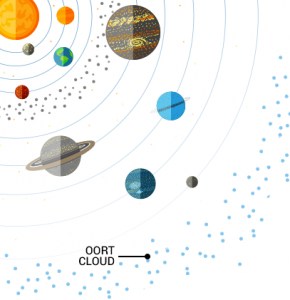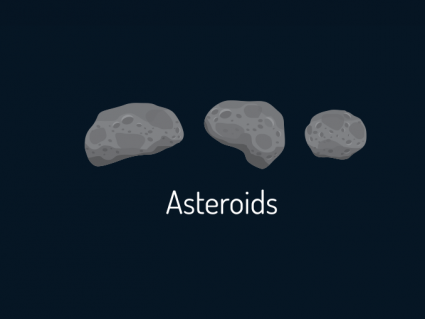5 Comet Facts: Dirty Snowballs of the Solar System

“Comets are balls of frozen gases mixed with pieces of rocks, water, and ice. Most comets zip around the outer edge of the solar system in the Oort cloud. When frozen, comets can be the size of a small town.”
Today, we’re going to count down the top 5 comet facts including:
Let’s get started.
1. Most comets are in the Oort Cloud

Most comets zip around the outer edge of our solar system in the Oort Cloud. This belt of comets that travel around stretches out at a distance of 50,000 to 200,000 AU.
There are lots of comets in the Oort Cloud. But they’re small and account for a small total volume.
Other than the Oort Cloud, comets exist in the Kuiper Belt which is home to many asteroids in the solar system. There are only a hundred or so named comets and a bit over 3500 known comets.
2. The anatomy of a comet

NUCLEUS: The frozen center of a comet is what’s known as the nucleus. This part contains frozen gas and dust particles.
COMA: When a comet passes closer to the sun, comets produce a surrounding glow known as a coma. These are gases like carbon monoxide, carbon dioxide, ammonia and methane that are released due to solar radiation.
TAIL: Some comets have tails that are from the effects of solar winds vaporizing. This is part of the nucleus streaming light also due to solar radiation.
3. Comets may have transported Earth’s water
Two theories exist for the origin of water on Earth:

- Water exited from inside Earth during volcano degassing.
- Comets transported water like a cargo ship to Earth.
No theory has been proven. But the purpose of ESA’s Rosetta mission was to get closer to understanding.
In a nutshell, Rosetta landed on a comet and found they had a higher ratio of “heavy water” also known as deuterium. On Earth, for every 10,000 water molecules on Earth, there are 3 deuterium atoms. But comets show significantly higher ratios of “heavy water”
By knowing comets show a higher ratio of deuterium, it makes the theory that water originated from comets less likely.
4. Halley’s Comet regularly swoops past Earth

Halley’s comet is the only comet that regularly orbits Earth and becomes visible to the human eye. The last appearance of Halley’s Comet in the inner solar system was in 1986. The next time it will again be visible is in 2061.
This highly elliptical comet was named after Edmund Halley who used the laws of motion to calculate its orbit.
The nucleus of Halley’s Comet is only about 15 kilometers across. We don’t know its mass but it’s estimated to be about 2.2×1014 kg.
5. Comets may have triggered the extinction of dinosaurs
The evidence of comets impacting the Earth is sparse. It’s a rare occasion, even in Earth’s 4.5-billion-year history. Two possible impacts in Earth’s history include:
CHICXULUB CRATER: About 60 million years ago, there was evidence that a comet or asteroid crashed into water east of Mexico. This impact was first revealed by the Chicxulub crater. Ultimately, it’s believed this triggered the extinction of the dinosaurs 65 million years ago. Although not proven, some scientists credit comets as the cause of the death of dinosaurs. This is because comets travel at enough speed and could release the energy to create an extinction event.
TUNGUSKA EVENT: In Siberia, the Tunguska event is the largest recorded impact in history. This large explosion occurred in Russia, on the morning of 30 June 1908. There is no certainty what caused the Tunguska event but it’s believed the impact was either caused by a comet or asteroid.
Overall, there is sparse evidence for comets crashing into Earth and the possibility of getting hit by comets is very rare.















About every 75 years. So next visit will be about 2061
How often does Halley’s comet go past Earth?